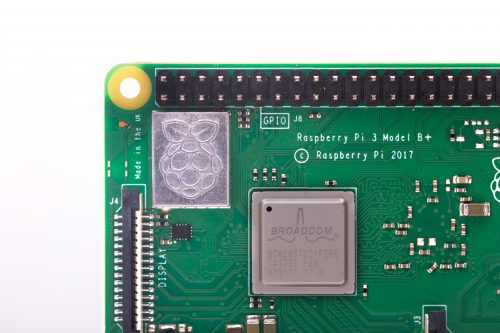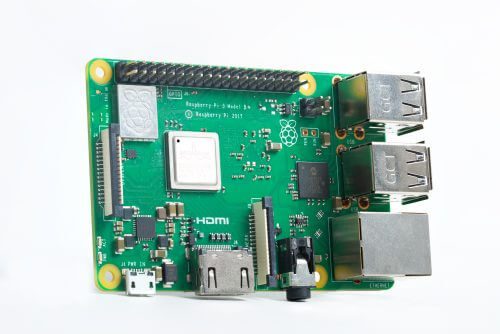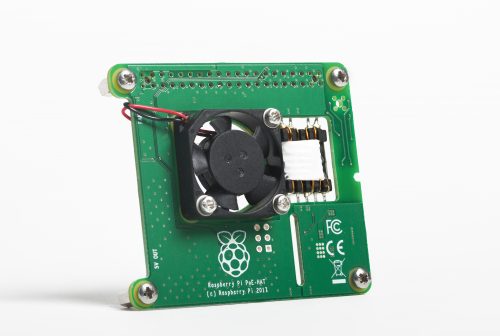Here’s a long post. We think you’ll find it interesting. If you don’t have time to read it all, we recommend you watch this video, which will fill you in with everything you need, and then head straight to the product page to fill yer boots. (We recommend the video anyway, even if you do have time for a long read. ‘Cos it’s fab.)
A BRAND-NEW PI FOR π DAY
Raspberry Pi 3 Model B+ is now on sale now for $35, featuring: – A 1.4GHz 64-bit quad-core ARM Cortex-A53 CPU – Dual-band 802.11ac wireless LAN and Bluetooth 4.2 – Faster Ethernet (Gigabit Ethernet over USB 2.0) – Power-over-Ethernet support (with separate PoE HAT) – Improved PXE network and USB mass-storage booting – Improved thermal management Alongside a 200MHz increase in peak CPU clock frequency, we have roughly three times the wired and wireless network throughput, and the ability to sustain high performance for much longer periods.
– Werbung –– Werbung –
If you’ve been a Raspberry Pi watcher for a while now, you’ll have a bit of a feel for how we update our products. Just over two years ago, we released Raspberry Pi 3 Model B. This was our first 64-bit product, and our first product to feature integrated wireless connectivity. Since then, we’ve sold over nine million Raspberry Pi 3 units (we’ve sold 19 million Raspberry Pis in total), which have been put to work in schools, homes, offices and factories all over the globe.
Those Raspberry Pi watchers will know that we have a history of releasing improved versions of our products a couple of years into their lives. The first example was Raspberry Pi 1 Model B+, which added two additional USB ports, introduced our current form factor, and rolled up a variety of other feedback from the community. Raspberry Pi 2 didn’t get this treatment, of course, as it was superseded after only one year; but it feels like it’s high time that Raspberry Pi 3 received the “plus” treatment.
So, without further ado, Raspberry Pi 3 Model B+ is now on sale for $35 (the same price as the existing Raspberry Pi 3 Model B), featuring:
- A 1.4GHz 64-bit quad-core ARM Cortex-A53 CPU
- Dual-band 802.11ac wireless LAN and Bluetooth 4.2
- Faster Ethernet (Gigabit Ethernet over USB 2.0)
- Power-over-Ethernet support (with separate PoE HAT)
- Improved PXE network and USB mass-storage booting
- Improved thermal management
Alongside a 200MHz increase in peak CPU clock frequency, we have roughly three times the wired and wireless network throughput, and the ability to sustain high performance for much longer periods.
Raspberry Pi 3B+ is available to buy today from our network of Approved Resellers.
New features, new chips
Roger Thornton did the design work on this revision of the Raspberry Pi. Here, he and I have a chat about what’s new.
Introducing the Raspberry Pi 3 Model B+
Raspberry Pi 3 Model B+ is now on sale now for $35, featuring: – A 1.4GHz 64-bit quad-core ARM Cortex-A53 CPU – Dual-band 802.11ac wireless LAN and Bluetooth 4.2 – Faster Ethernet (Gigabit Ethernet over USB 2.0) – Power-over-Ethernet support (with separate PoE HAT) – Improved PXE network and USB mass-storage booting – Improved thermal management Alongside a 200MHz increase in peak CPU clock frequency, we have roughly three times the wired and wireless network throughput, and the ability to sustain high performance for much longer periods.
The new product is built around BCM2837B0, an updated version of the 64-bit Broadcom application processor used in Raspberry Pi 3B, which incorporates power integrity optimisations, and a heat spreader (that’s the shiny metal bit you can see in the photos). Together these allow us to reach higher clock frequencies (or to run at lower voltages to reduce power consumption), and to more accurately monitor and control the temperature of the chip.
Dual-band wireless LAN and Bluetooth are provided by the Cypress CYW43455 “combo” chip, connected to a Proant PCB antenna similar to the one used on Raspberry Pi Zero W. Compared to its predecessor, Raspberry Pi 3B+ delivers somewhat better performance in the 2.4GHz band, and far better performance in the 5GHz band, as demonstrated by these iperf results from LibreELEC developer Milhouse.
| Tx bandwidth (Mb/s) | Rx bandwidth (Mb/s) | |
| Raspberry Pi 3B | 35.7 | 35.6 |
| Raspberry Pi 3B+ (2.4GHz) | 46.7 | 46.3 |
| Raspberry Pi 3B+ (5GHz) | 102 | 102 |
The wireless circuitry is encapsulated under a metal shield, rather fetchingly embossed with our logo. This has allowed us to certify the entire board as a radio module under FCC rules, which in turn will significantly reduce the cost of conformance testing Raspberry Pi-based products.

We’ll be teaching metalwork next.
Previous Raspberry Pi devices have used the LAN951x family of chips, which combine a USB hub and 10/100 Ethernet controller. For Raspberry Pi 3B+, Microchip have supported us with an upgraded version, LAN7515, which supports Gigabit Ethernet. While the USB 2.0 connection to the application processor limits the available bandwidth, we still see roughly a threefold increase in throughput compared to Raspberry Pi 3B. Again, here are some typical iperf results.
| Tx bandwidth (Mb/s) | Rx bandwidth (Mb/s) | |
| Raspberry Pi 3B | 94.1 | 95.5 |
| Raspberry Pi 3B+ | 315 | 315 |
We use a magjack that supports Power over Ethernet (PoE), and bring the relevant signals to a new 4-pin header. We will shortly launch a PoE HAT which can generate the 5V necessary to power the Raspberry Pi from the 48V PoE supply.
Raspberry Pi 3B was our first product to support PXE Ethernet boot. Testing it in the wild shook out a number of compatibility issues with particular switches and traffic environments. Gordon has rolled up fixes for all known issues into the BCM2837B0 boot ROM, and PXE boot is now enabled by default.
Clocking, voltages and thermals
The improved power integrity of the BCM2837B0 package, and the improved regulation accuracy of our new MaxLinear MxL7704 power management IC, have allowed us to tune our clocking and voltage rules for both better peak performance and longer-duration sustained performance.
Below 70°C, we use the improvements to increase the core frequency to 1.4GHz. Above 70°C, we drop to 1.2GHz, and use the improvements to decrease the core voltage, increasing the period of time before we reach our 80°C thermal throttle; the reduction in power consumption is such that many use cases will never reach the throttle. Like a modern smartphone, we treat the thermal mass of the device as a resource, to be spent carefully with the goal of optimising user experience.
This graph, courtesy of Gareth Halfacree, demonstrates that Raspberry Pi 3B+ runs faster and at a lower temperature for the duration of an eight‑minute quad‑core Sysbench CPU test.
Note that Raspberry Pi 3B+ does consume substantially more power than its predecessor. We strongly encourage you to use a high-quality 2.5A power supply, such as the official Raspberry Pi Universal Power Supply.
FAQs
We’ll keep updating this list over the next couple of days, but here are a few to get you started.
Are you discontinuing earlier Raspberry Pi models?
No. We have a lot of industrial customers who will want to stick with the existing products for the time being. We’ll keep building these models for as long as there’s demand. Raspberry Pi 1B+, Raspberry Pi 2B, and Raspberry Pi 3B will continue to sell for $25, $35, and $35 respectively.
What about Model A+?
Raspberry Pi 1A+ continues to be the $20 entry-level “big” Raspberry Pi for the time being. We are considering the possibility of producing a Raspberry Pi 3A+ in due course.
What about the Compute Module?
CM1, CM3 and CM3L will continue to be available. We may offer versions of CM3 and CM3L with BCM2837B0 in due course, depending on customer demand.
Are you still using VideoCore?
Yes. VideoCore IV 3D is the only publicly-documented 3D graphics core for ARM‑based SoCs, and we want to make Raspberry Pi more open over time, not less.
Credits
A project like this requires a vast amount of focused work from a large team over an extended period. Particular credit is due to Roger Thornton, who designed the board and ran the exhaustive (and exhausting) RF compliance campaign, and to the team at the Sony UK Technology Centre in Pencoed, South Wales. A partial list of others who made major direct contributions to the BCM2837B0 chip program, CYW43455 integration, LAN7515 and MxL7704 developments, and Raspberry Pi 3B+ itself follows:
James Adams, David Armour, Jonathan Bell, Maria Blazquez, Jamie Brogan-Shaw, Mike Buffham, Rob Campling, Cindy Cao, Victor Carmon, KK Chan, Nick Chase, Nigel Cheetham, Scott Clark, Nigel Clift, Dominic Cobley, Peter Coyle, John Cronk, Di Dai, Kurt Dennis, David Doyle, Andrew Edwards, Phil Elwell, John Ferdinand, Doug Freegard, Ian Furlong, Shawn Guo, Philip Harrison, Jason Hicks, Stefan Ho, Andrew Hoare, Gordon Hollingworth, Tuomas Hollman, EikPei Hu, James Hughes, Andy Hulbert, Anand Jain, David John, Prasanna Kerekoppa, Shaik Labeeb, Trevor Latham, Steve Le, David Lee, David Lewsey, Sherman Li, Xizhe Li, Simon Long, Fu Luo Larson, Juan Martinez, Sandhya Menon, Ben Mercer, James Mills, Max Passell, Mark Perry, Eric Phiri, Ashwin Rao, Justin Rees, James Reilly, Matt Rowley, Akshaye Sama, Ian Saturley, Serge Schneider, Manuel Sedlmair, Shawn Shadburn, Veeresh Shivashimper, Graham Smith, Ben Stephens, Mike Stimson, Yuree Tchong, Stuart Thomson, John Wadsworth, Ian Watch, Sarah Williams, Jason Zhu.
If you’re not on this list and think you should be, please let me know, and accept my apologies.
Website: LINK




Schreibe einen Kommentar
Du musst angemeldet sein, um einen Kommentar abzugeben.